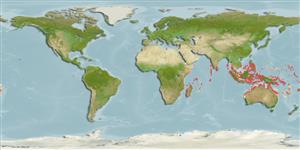>
Gobiiformes (Gobies) >
Gobiidae (Gobies) > Gobiinae
Etymology: Istigobius: Greek, istios = sail + Latin, gobius = gudgeon (Ref. 45335).
Eponymy: Charles Francis Spence (1907–1982) was a businessman in Mozambique, the type locality, whom Smith thanked for providing personal assistance. Spence later published: The Portuguese Colony of Moçambique: an Economic Survey (1951). (Ref. 128868), visit book page.
More on author: Smith.
Environment: milieu / climate zone / profondeur / distribution range
Écologie
marin; saumâtre récifal; profondeur 1 - 12 m (Ref. 90102). Tropical; 15°N - 40°S
Indo-Pacific: Mozambique, Kenya, Sri Lanka, Papua New Guinea, Australia, and Micronesia; undoubtedly more widespread.
Taille / Poids / Âge
Maturité: Lm ? range ? - ? cm
Max length : 7.9 cm SL mâle / non sexé; (Ref. 1602)
Épines dorsales (Total) : 7; Rayons mous dorsaux (Total) : 10 - 11; Épines anales: 1; Rayons mous anaux: 9 - 10; Vertèbres: 26. Pectoral fin rays entire. Predorsal cycloid scale 7-10, ctenoid on trunk. Few spots on nape; a dusky line running from eye dorsal to sensory pore path, ending at or before pectoral fin base; wavy brown lines on the snout. Pelvic and distal part of anal fins darker in males than in females. Appressed anal fin reaching within a distance of 1-2 scales of caudal fin in male, 2-4 scales in female; appressed 2nd dorsal slightly overlapping caudal in male. Some males exhibit 3-4 vertical bars on abdomen and 2-3 horizontal bars in 1st dorsal fin (Ref. 420); longitudinal scale series 30-32; no scales on cheek and opercle; body depth 4.9-6.1 in SL (Ref. 90102).
Body shape (shape guide): fusiform / normal; Cross section: circular.
Occurs in turbid coastal areas near river mouths at less than 1 m to at least 12 m, Ref. 48637.
Life cycle and mating behavior
Maturité | Reproduction | Frai | Œufs | Fécondité | Larves
Genital papilla of male reaching anal spine. Female genital papilla truncate, ending well before origin of anal fin.
Murdy, E.O. and D.F. Hoese, 1985. Revision of the gobiid fish genus Istigobius. Indo-Pac. Fish. (4):41 p. (Ref. 420)
Statut dans la liste rouge de l'IUCN (Ref. 130435: Version 2025-1)
Menace pour l'homme
Harmless
Utilisations par l'homme
Outils
Articles particuliers
Télécharger en XML
Sources Internet
Estimates based on models
Preferred temperature (Réf.
123201): 25.7 - 29.3, mean 28.6 °C (based on 2615 cells).
Phylogenetic diversity index (Réf.
82804): PD
50 = 0.5005 [Uniqueness, from 0.5 = low to 2.0 = high].
Bayesian length-weight: a=0.01023 (0.00477 - 0.02194), b=3.01 (2.83 - 3.19), in cm total length, based on LWR estimates for this (Sub)family-body shape (Ref.
93245).
Niveau trophique (Réf.
69278): 3.3 ±0.4 se; based on size and trophs of closest relatives
Résilience (Réf.
120179): Haut, temps minimum de doublement de population inférieur à 15 mois (Preliminary K or Fecundity.).
Fishing Vulnerability (Ref.
59153): Low vulnerability (10 of 100).
🛈
Nutrients (Ref.
124155): Calcium = 139 [69, 301] mg/100g; Iron = 0.849 [0.417, 1.558] mg/100g; Protein = 18.7 [16.7, 20.3] %; Omega3 = 0.153 [0.067, 0.292] g/100g; Selenium = 16.6 [8.1, 37.8] μg/100g; VitaminA = 145 [39, 485] μg/100g; Zinc = 2.53 [1.67, 3.75] mg/100g (wet weight);
